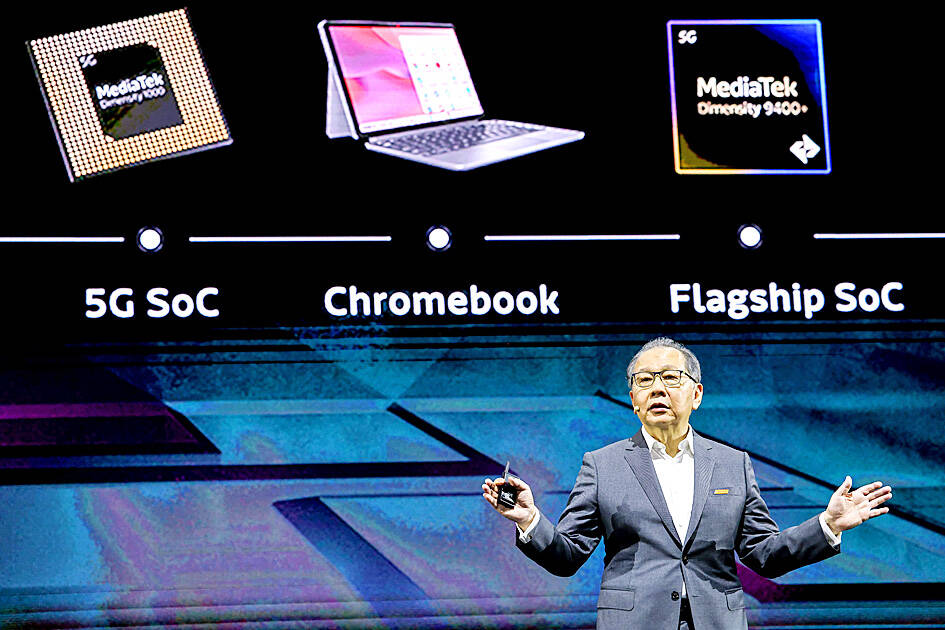MediaTek Inc (聯發科), the world’s biggest supplier of smartphone chips, yesterday said the tape-out process for its first 2-nanometer chip would take place in September, paving the way for volume production of its most advanced chip, likely to be its next-generation flagship smartphone chip, around the year-end at the earliest.
MediaTek has been leveraging advanced process technologies from its foundry partner, Taiwan Semiconductor Manufacturing Co (TSMC, 台積電), to build its flagship mobile phone chips, a segment it once relinquished and then recovered four years ago as it released its Dimensity series.
In the semiconductor industry, a tape-out refers to the final stage of the chip design cycle before it is sent for manufacturing.

MediaTek’s most advanced mobile chip available is the Dimensity 9400, made on TSMC’s 3-nanometer process technology. The chip delivers a 25 percent power efficiency improvement and 15 percent enhancement in performance compared with its predecessor, MediaTek said.
“We are now moving into 2-nanometer [technology]. We will be taping out our first 2-nanometer device in September this year. Of course, this is a high-volume chip,” MediaTek chief executive officer Rick Tsai (蔡力行) said during his Computex keynote speech in Taipei themed “AI for Everyone: From Edge to Cloud.”
“You probably can guess what: 2 nanometers. I’m not allowed to announce, cause J.C. is here,” Tsai said, referring J.C. Hsu (徐敬全), MediaTek senior vice president in charge of wireless communications.
Tsai did not specify which product the 2 nanometer technology would be used to build.
MediaTek apparently would continue adopting next generations of technologies that follow Moore’s Law.
MediaTek said that as chip production technology is advancing to angstrom level, it would adopt 16A or 14A chips based on its long-term roadmap, Tsai said.
TSMC would start volume production of its 16A chips in the second half of next year.
“Whatever [technology] after that, MediaTek is in,” Tsai said.
MediaTek has been diversifying its product lines to minimize operational risks. Mobile chips remain the biggest revenue source of the company, making up about 56 percent of its total revenue last quarter.
Two years ago, MediaTek expanded its business scope to supply automotive chips, and most recently application-specific integrated circuits (ASIC), artificial intelligence (AI) accelerators for cloud-based data center operators and super chips, in collaboration with Nvidia Corp.
As AI data center chips are usually much larger than those for mobile phones or TVs, “people wonder if MediaTek can do that, as it is known as a consumer electronics company. Yes, we can,” Tsai said.
MediaTek has a record of accomplishment in developing ASICs for data centers, he said.
The company is ready to supply four different sizes of chips, from a type of mobile phone chip to an automotive chip and two big networking chips, including one equipped with high-band-width memory (HBM) chips, he said.
The company’s networking chip with HBM chips has been under volume production for more than one year, measuring 91x91mm2, he said.
As for super chips, MediaTek would be supplying chips used in Nvidia’s new AI-based personal device, DGX Spark, Tsai said.
Nvidia did not disclose the product’s launch date, but CEO Jensen Huang (黃仁勳) said that it would make a good Christmas present.

 www.taipeitimes.com
www.taipeitimes.com
MediaTek has been leveraging advanced process technologies from its foundry partner, Taiwan Semiconductor Manufacturing Co (TSMC, 台積電), to build its flagship mobile phone chips, a segment it once relinquished and then recovered four years ago as it released its Dimensity series.
In the semiconductor industry, a tape-out refers to the final stage of the chip design cycle before it is sent for manufacturing.

MediaTek CEO Rick Tsai delivers his keynote speech for Computex at the Taipei Nangang Exhibition Center yesterday.
Photo: I-hwa Cheng, AFPMediaTek’s most advanced mobile chip available is the Dimensity 9400, made on TSMC’s 3-nanometer process technology. The chip delivers a 25 percent power efficiency improvement and 15 percent enhancement in performance compared with its predecessor, MediaTek said.
“We are now moving into 2-nanometer [technology]. We will be taping out our first 2-nanometer device in September this year. Of course, this is a high-volume chip,” MediaTek chief executive officer Rick Tsai (蔡力行) said during his Computex keynote speech in Taipei themed “AI for Everyone: From Edge to Cloud.”
“You probably can guess what: 2 nanometers. I’m not allowed to announce, cause J.C. is here,” Tsai said, referring J.C. Hsu (徐敬全), MediaTek senior vice president in charge of wireless communications.
Tsai did not specify which product the 2 nanometer technology would be used to build.
MediaTek apparently would continue adopting next generations of technologies that follow Moore’s Law.
MediaTek said that as chip production technology is advancing to angstrom level, it would adopt 16A or 14A chips based on its long-term roadmap, Tsai said.
TSMC would start volume production of its 16A chips in the second half of next year.
“Whatever [technology] after that, MediaTek is in,” Tsai said.
MediaTek has been diversifying its product lines to minimize operational risks. Mobile chips remain the biggest revenue source of the company, making up about 56 percent of its total revenue last quarter.
Two years ago, MediaTek expanded its business scope to supply automotive chips, and most recently application-specific integrated circuits (ASIC), artificial intelligence (AI) accelerators for cloud-based data center operators and super chips, in collaboration with Nvidia Corp.
As AI data center chips are usually much larger than those for mobile phones or TVs, “people wonder if MediaTek can do that, as it is known as a consumer electronics company. Yes, we can,” Tsai said.
MediaTek has a record of accomplishment in developing ASICs for data centers, he said.
The company is ready to supply four different sizes of chips, from a type of mobile phone chip to an automotive chip and two big networking chips, including one equipped with high-band-width memory (HBM) chips, he said.
The company’s networking chip with HBM chips has been under volume production for more than one year, measuring 91x91mm2, he said.
As for super chips, MediaTek would be supplying chips used in Nvidia’s new AI-based personal device, DGX Spark, Tsai said.
Nvidia did not disclose the product’s launch date, but CEO Jensen Huang (黃仁勳) said that it would make a good Christmas present.

MediaTek unveils progress of 2nm chip - Taipei Times
Bringing Taiwan to the World and the World to Taiwan
